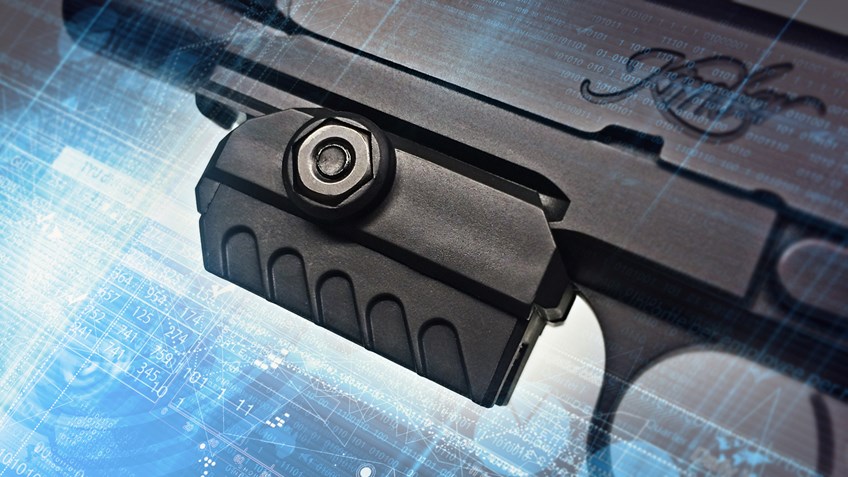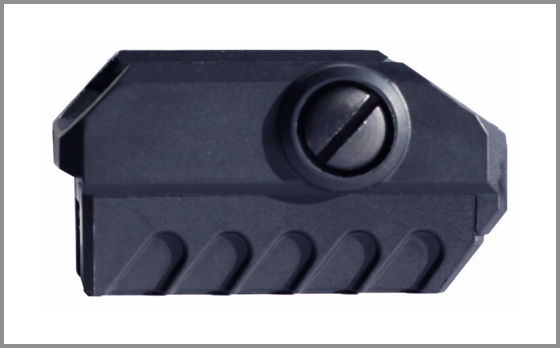This new training aid is worth well more than its cost in ammo. Find out what it is…
by Frank Winn, Guns & Gear Editor
NRA America’s 1st Freedom
How enthusiastic would you be about a device that could turn you into a better pistol (or rifle) shooter in a hurry; weighed essentially nothing; worked on a huge variety of firearms; played no favorites by gender, stature, handedness (or hat-size, for that matter); worked in both dry- and live-fire modes; and could be had for a few week’s worth of pocket change?
Yeah — us too. So we present the MantisX Firearms Training System.
Physically, it’s an underwhelming sort of kit: A bland-looking Picatinny-attachable component (packed in the smallest Pelican case we’ve ever seen) comprises a compact sensor, and is accompanied by a single sheet of instructions and a USB-to-mini-USB charging cable. But unfold that sheet of paper, and you’ll start to cheer up, we promise. Eight steps that would fit legibly on both sides of a business card may be all you’ll ever read about the MantisX.
While we have suspicions about the need behind the complexity of the nuts and bolts, the concept behind the device is simple. Step One of those instructions is to get the brains to your phone — a free App Store or Google Play download — and Step Two puts the device on your rail. Next come prompted and self-terminating connection and calibration steps, and now you’re ready to train. Just push “start,” and you’re rolling. (Unless you’re at the range, remember to make sure a dry-fire session is truly dry: NO LIVE AMMO IN THE SAME ROOM AS YOU ARE.)
The sensor and your smart device are now monitoring the movements of your pistol in near real time. The data stream that the sensor sends is stripped of the crucial milliseconds around the hammer or striker fall, and the segment compared to the “still” calibration position. Large-amplitude movements like cycling and actual shots are filtered out. The result is shot-by-shot analysis of your movements in generating the trigger press. Individual shots are scored, and the string as a whole is averaged on a 0-to-100 scale (100 demonstrates you’ve introduced no extraneous movement).
A lot of what you’ll see on your smart device in “Train” mode will remind you of a “Common Errors and Corrections” target that’s been around for years and years — one of those teaching aids that we love and hate at the same time. Pretty much everybody has seen these. They’re a spider-web-looking sort of target with a very pronounced center aim point, and labels that really give them away. They’re intended to help you identify and correct many gripping-architecture/mechanics problems that, if repeated, cause shots to stray in predictable ways. So far, so good. Their shortcomings are more difficult to apprehend, and the biggest are inseparably tandem: They have handedness (different for righties and lefties) built in, and this means they’re truly helpful only when you shoot on them with the named, single hand. As this is a huge departure from modern technique — both hands pressed together around the pistol grip just for starters — it’s no wonder their utility begins to fade. Certainly, their cues to remedy misdirected shots become less useful.
You can use your MantisX system in this way. In fact, knock yourself out: You will develop a fine trigger press with either hand. But don’t think for a second that the MantisX software shares the limitations of paper predecessors. Take a look at the “Learn” screens, and you’ll see that two-handed technique has been accounted for in the software. Whether the training suggestions are utterly perfect or not will soon be an afterthought. The real power is in revealing those tiny corrupting movements you had no idea you were making.
Two additional “Train” mode displays are where this becomes clear. The first is a line graph that looks a little bland on first inspection: Your string gets plotted left to right on the zero-to-100 scale as shots are made. Overlaid on this is a running average, recomputed and displayed as a line across the inevitable zig-zag of the successive, individual shots.
With an efficiency matched by nothing else we know, the MantisX gets you closer to repeatability in that all-important press.
This isn’t as ho-hum as it may sound, though it’s a little hard to describe why. We think the graphical presentation of the relative stillness of each shot is simply more obvious in the line plot: Shots that feel very similar will measure quite differently and — sometimes glaringly — illustrate the disastrous compounding of flaws that routinely spoils what feels like a technically sound shot. Nothing makes this clearer than an ugly, obvious 20- or even 40-point bounce from one press to the next. But stick with it, and this is where the near-magic happens. Between the MantisX sensor, software and your brain, a feedback loop is built, and we think you’ll be as astonished and impressed as we were how rapidly those infuriating swings begin to moderate. With an efficiency matched by nothing else we know, the MantisX gets you closer to repeatability in that all-important press.
The third Train-mode screen gives even better detail on variations in one crucial sense. While it goes back to the “bucket” display mode where shots are grouped by error type, it shows the degree of error, rather than a simple count. Reading this is therefore a bit more subtle: If you have small, concentric slivers all around the center, your technique is likely very sound. The mistakes you’re making are causing very small angular deviations, and are approaching irreducible levels that reflect biologic immutables (pulse, respiration, etc.), not technique blunders.
If your pattern is more spoke-like — with larger/deeper arcs more scattered — then your score will be lower, too. You may have fewer errors, but their magnitude is such that they’ll have big(ger) impacts on downrange results.
While it’s easy to get excited about the actual shooting benefits of the MantisX system, it’d be an injustice to overlook some other fine attributes. A favorite is the charging method: The supplied cable lets you charge your sensor in any handy USB. We have no idea why there isn’t more of this in small devices of every type.
Next is that charging port itself. If you plan to do mostly dryfire work and have a pistol to which you’ll leave the sensor mounted (don’t forget — it works with CO2 and Airsoft too), such a mount can be made with the port accessible; that is, pointing forward to make plug-in dead easy. If you are using the sensor in live fire, you’ll be well-advised to turn the charging connection rearward so that carbon and other detritus don’t find their way into the connector. Just remember, this is parameter for the sensor, and creates push/pull assessment errors if not set on the “Settings” screen.
We can hear some of you thinking, by the way. “Gee, what would it be like on my rifle?” That is easily answered in two ways. First, we tried it, and it works just fine, though obviously the technique tips are mostly meaningless because grip is so different. But in terms of telling you how “quiet” you are physically at the moment you break the shot, it’s grand. Second, and not coincidentally, MantisX tells us that a rifle version of the software is already well along and due this summer.
A “History” mode is built into the MantisX software, too, and it’s about as self-explanatory as it could be. It stores each string as a bar graph in 0-to-100 scale, and contains the individual “Train” mode results (all three plots). It divvies them up by “live,” “dry” and “all,” as well as presenting some summary statistics. All are shareable as well.
We expect it’s clear that the more we fiddle with the MantisX, the more we like it. It’s clever, reliable and affordable, and will allow disproportionately rapid improvement for modest investments along several axes. But make no mistake: Its genius is not merely in forging some new paradigm, but also in refocusing and capitalizing on a time-tested one. It will put the fun back in dry fire. And if we’re honest, the more seasoned you get, the more boring this becomes. Heck, the MantisX even allows this to become a mildly competitive pursuit, if you like.
As to a new paradigm, we’d suggest it does this too. Nothing in (LOUD) shouting distance allows a reconnection between dry and live practice like the MantisX system. Making one pay dividends for the other has never been frankly transparent, and we think that’s about to change.
If you’ll take our advice, don’t be on the tail end of finding out.
Visit MantisX site HERE
MSRP of the MantisX Firearms Training Systems is $149.99












